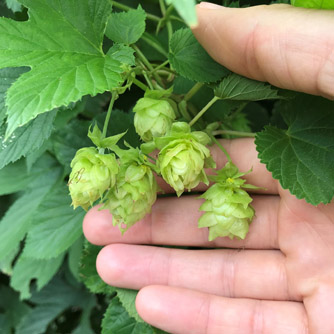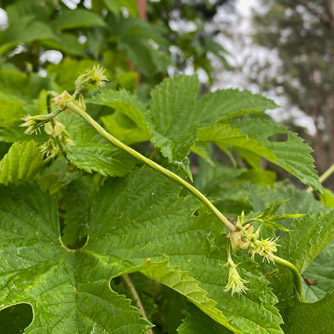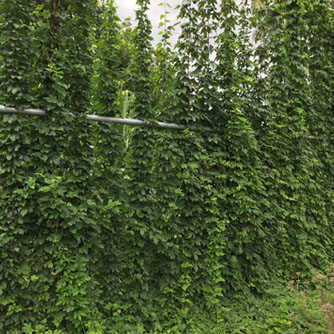Hops
BackHops (Humuls lupulus) is a fast growing climber that is best known as an ingredient in beer. However it also make a great addition to any backyard by providing summer shade and delightful aromas when you gently crush the light green flowers in mid to late summer. The flowers, known as cones or strobiles, have papery petals and are only produced on female plants. Inside each is a yellow gland called the lupulin where the essential oils and acids profile of that hops varieties is contained.
For beer lovers without hops beer would be remarkably sweet thanks to the use of malts in the brewing process. It’s the added hops that impart bitterness, flavour and aroma, and also act as a natural preservative. Different hop varieties have their own flavour profile and can impart flavours of citrus, pine, floral, fruit and more. The strength of the bitterness is controlled by when the brewer adds the hops and also which variety, or combination of varieties, is used.
On a technical note hops plants are called a twining vine or bine. Regular vines use suckers or tendrils for support whereas bines wrap their whole stem around things in order to climb. Something to remember next time you’re playing trivia!

Hops flowers close to harvest
How to Grow Hops
Hops bines are fast growing perennial climbers that will need a strong, tall support structure to grow up. Consider either a pole support system or a trestle against a wall or fence for extra height. Most varieties can climb up to 3 metres and they’ll happily wind around rope suspended from tall tree branches or support structures.
The plants require a winter chill period for successful fruiting, so they are well suited to growing in zones with cold winters. It explains why plants have historically been grown in southern Australia. However we have seen them growing successfully in cool spots in Brisbane so worth trying in places with mild winters even if it’s just for the benefit of the summer shade they provide. Note that plants die right back to the ground in winter.
Plant hops in a full sun spot, into a rich, well drained soil that has had plenty of organic matter added. Keep them a good metre or more away from other tall growing plants if possible or be prepared to trim off rogue stems that reach out and latch on looking to grow up.
Hops can be purchased as dormant rhizomes in autumn and winter or as young plants from nurseries in spring. Plant these into your chosen spot and water in with OCP eco-seaweed to help them establish. These are thirsty plants, especially when fully grown, so cover with mulch and be generous with your watering during summer.

Young female hops flowers developing
Fertilising Hops
Being fast growers hops will benefit from plenty of nutrients. During the growing season give them fortnightly doses of OCP eco-aminogro and OCP eco-seaweed for strong, healthy growth and lots of flowers. Each winter topdress the dormant rhizomes with a layer of compost or aged manure.
Pests & Diseases of Hops
- Snails & slugs – in spring the new shoots are susceptible to snail and slug attack so scatter OCP eco-shield around each plant to organically control these pests.
- Powdery mildew – with such dense leaf canopy the bines can be susceptible to mildew outbreaks. It helps to thin out branches and leaf growth to improve air circulation as well giving regular foliar sprays of OCP eco-seaweed and OCP eco-aminogro to promote healthier growth. If the problem persists then spray with an organic fungicide.
- Mites – if the leaves start to look faded or mottled then check for sap sucking mites which are more likely to attack plants during hot dry weather. Ornamental plants can be treated with OCP eco-neem but if picking the flowers then spray with an organic insecticide approved for edible plants.
- Caterpillars – if young plants are attacked then pick off caterpillars by hand or spray with OCP eco-caterpillar killer. Fully grown bines can handle some chomped leaves without much worry.
- Weeds – given how thirsty hops are it’s important to deal with weeds that will complete for water. Keep the mulch topped up to limit weed growth and spray any that do appear with OCP Slasher.

Hops growing on a large scale
Harvesting Hops
The flowers are normally harvested in autumn when they have turned bronze and are no longer bright green. If you squash and rub the flower between your fingers it will release a beautiful hoppy aroma and usually leave a yellow stain from the lupulin. These are all indications that it’s time to harvest your hops. Note that you might need to do a couple of harvests if all the flowers aren’t ready at the same time.
Carefully remove the flowers from the bine and then remove their stalks. Lay them out in a single layer on a clean sheet, draped over a clotheshorse. Place in a cool, dry spot out of direct sunlight to dry a bit further for 3-7 days. Once they are completely dry they can be placed into vacuum sealed bags for storage or frozen in ziplock bags until you’re ready to use them in home-brewed beer.
Once you’ve harvested all the flowers, cut the leafy bine back to about 1 metre above the ground. The plant will then put energy into building up the rhizome so do keep watering and feeding. When the first frost hits it will brown off even further and can be cut right back to ground level.
Hops Varieties to Try
- ‘Cascade’ - Brings medium intensity floral, citrus and grapefruit tones to beer. Suits use in typical American-style Pale Ale. Well-balance bittering potential and good for hop drying.
- ‘Pride of Ringwood’ - Adds a pronounced and pleasant cedar, oak and herbal tones. Distinctly Australian aroma well suited to our Pale Ales.
- ‘Goldings’ - With mild and delicate, sweet floral characteristics this traditional English variety is typically added to “Bitter” style beers.
- ‘Hersbrucker Hops’ – provides a combination of floral, fruity and spicy characteristics and is well known for being used in German Lagers.

Hops on a small growing frame


